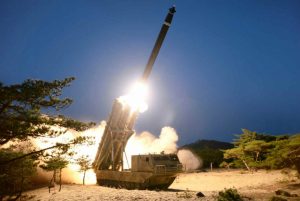Editor’s Note: The following is a preview of the latest edition of the APAC Risk Newsletter, presented by Diplomat Risk Intelligence. To read the full newsletter, click here to subscribe for free.
As the rest of the world watches with horror as the COVID–19 pandemic spills across borders, claiming hundreds of lives each day, North Korea has sought to project an image that it’s all business as usual in the country. To underscore that point: March 2020 marked the single busiest missile testing month in the country’s history, with eight separate missiles launched over four events. After a lull in missile testing through December, January, and February, Kim Jong Un made sure that national defense preparations returned to their usual springtime intensity.
In the Kim Jong Un era, March has usually meant a step-up in missile and military activity from North Korea in general. Before 2018, this was usually a tit-for-tat reaction to the U.S.-South Korea springtime exercises, formerly known as Key Resolve and Foal Eagle. In 2020, the alliance called off its springtime drills as South Korea faced a reckoning with COVID–19.
To be sure, North Korea has not brushed off the pandemic. Indeed, not long after the outbreak in China’s Hubei province, North Korean state media was frank in describing the then-epidemic as a threat to the country’s “national survival.” Senior North Korean officials—but not Kim Jong Un—were photographed wearing face masks in the course of their regular duties. By the start of March’s military activities, Kim was surrounded by Korean People’s Army officers clad in face masks, indicating that COVID–19 lingered in the background of this seeming return to military normalcy: the message was that even the pandemic would not deter North Korea from maintaining military readiness.
By the final missile tests of March, the face masks were gone and North Korea was projecting that it had overcome the pandemic. This is unlikely to be true, even as the country has yet to declare a single confirmed case of the virus (either due to propaganda concerns, or simply because it lacks the diagnostic capacity to do so). In an interview with Voice of American and CNN on Thursday, General Robert Abrams, the commander of U.S. Forces Korea, said he thought that North Korea was making an “impossible claim.” He said that U.S. intelligence suggested that North Korea had cases of the virus, just like every country in the region. He added the following:
I do know by their actions that for about 30 days in February, early March, that their military was locked down. And they took draconian measures at their border crossings and inside their formations to do exactly what everybody else is doing, which is stop the spread.
That matches other known evidence. In January, for instance, satellite imagery suggested that North Korean troops were preparing for a probable February 8 military parade—as they had done in 2018. That parade could have been a moment to celebrate the hard-line policy laid out by Kim Jong Un at the Fifth Plenum of the 7th Central Committee of the Workers’ Party of Korea in December 2019, but it was promptly called off as the country went into a lockdown over COVID–19, including by closing its borders and preventing all travel in and out of its borders (result in, among other things, a total collapse in its exports to China, as Troy Stangarone discussed in The Diplomat recently). Indeed, North Korea’s COVID–19 containment efforts are going to be the closest thing to a natural experiment in what “maximum pressure” might actually like.
As April begins, North Korea has turned its attention back toward the United States, taking aim at Secretary of State Mike Pompeo for his statement after a G7 foreign ministers call that the countries should remain united against North Korea—and that sanctions relief should only be offered up for total denuclearization. A recent Foreign Ministry statement out of the country promised “payback,” suggesting that Pyongyang could step up its provocations to even transgress what has long been seen as a “red line” for U.S. President Donald J. Trump: the resumption of either long-range missile or nuclear weapons testing. Pyongyang may sense a weakened United States, distracted by the spread of COVID–19 within its own borders. In an incredible development, the country’s state television featured footage of White House press briefings on the virus situation in the United States.
All of this raises the question of how North Korea is likely to play its cards between now and the November U.S. elections. Kim Jong Un has already teased a “new strategic weapon”—something that might be shown off with a test or perhaps at an October 10, 2020, parade to commemorate the 75th anniversary of the founding of the Workers’ Party of Korea. Even as much remains unclear about how the country is faring internally with COVID–19, Pyongyang appears determined to signal that everything remains on track. As the same statement that bashed Pompeo last month put it, North Korea is determined to continue to go its “own way.”
Bottom Line: Pyongyang is pushing ahead with military testing and development, even as COVID–19 seizes global attention and energy.
Don’t Miss It: On the latest episode of the Asia Geopolitics podcast, my co-host Prashanth Parameswaran and I talk about North Korea’s busy March and what might lie ahead for the country. As always, if you like the podcast and have suggestions for future episodes, please get in touch.
To read the entirety of the latest edition of the APAC Risk Newsletter, presented by Diplomat Risk Intelligence, click here to read and subscribe for free.

































